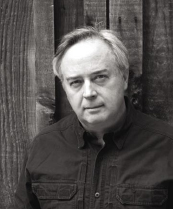Essay: Verlyn Klinkenborg
|
|
| Photo courtesy of Verlyn Klinkenborg |
Renewing America's commitment to high-energy physics
In October 2003, I gave an evening talk at the Fermi National Accelerator Laboratory in Batavia, Illinois. The subject was nature on the familiar scale, the kind embodied in the restored prairie on the Fermilab campus–some 1200 acres of compass plant and rattlesnake master and other species. But it's impossible to visit a place like Fermilab without thinking about nature on another dimension, the subatomic one being studied in the Tevatron collider, which looks from the sky like an enormous, moated ring.
In the Tevatron, subatomic particles are accelerated to extremely high speeds and crashed into each other within a detector chamber. That afternoon, I clambered through the scaffolding around the detector chamber as scientists tried to explain to me what it all meant. To me it looked like an incomprehensible array of electronics several stories high. The detector's purpose is to capture a computerized image of the debris of each antiproton-proton collision. The particles that emerge–varieties of quarks and mesons, for instance–seem at first to have nothing to do with nature as we know it on the human scale.
Except, of course, that they have everything to do with how the universe itself was formed.
There is a basic rule about colliders. The smaller or more evanescent the particle you are trying to observe, the more energy it takes. Studying particle collisions at ever higher and higher energies is the only way to directly investigate the conditions that prevailed during the earliest microfractions of a second after the Big Bang. Moving further back in time–closer to the Big Bang–will mean bigger machines.
At Fermilab, many people were looking almost wistfully over the horizon to 2007, when the Large Hadron Collider outside Geneva comes on line. That is where the coming generation of groundbreaking experiments will take place.
The planning for the next particle accelerator after the Large Hadron Collider–the International Linear Collider, some 20 miles long–has already begun, and there is serious debate about where to build it. Recently, a National Research Council panel recommended that the United States should make a determined effort to build the International Linear Collider in this country as part of an international consortium.
There's no globalization like the globalization of science. A single major experiment at Fermilab often involves dozens, if not hundreds, of physicists and technicians from all over the world. The same will be true at the Large Hadron Collider, which is run by a 20-nation coalition. The research in Illinois has shaped the research planned for Switzerland, and those experiments will in turn shape the experiments planned for the International Linear Collider. But that doesn't mean there aren't significant advantages to being the project's host. If it isn't built here, American scientists will go wherever it is built to do their research. The overwhelming risk, the panel concluded, is that without this project, the thrust of high-energy physics in this country will simply die away.
This country desperately needs to recommit itself to basic research. In the 21st century, a particle collider 20 miles long happens to be one version of what basic research looks like. High-energy physics is hard to explain to the public. It cannot be justified in simple, pragmatic payoffs for American consumers, or simple, pragmatic payoffs for politicians.
But the justification is simple. Do we continue to ask fundamental questions about the universe we live in, or do we not? To me, there is only one answer. The very soul of who we are as a species, at our very best, is expressed in our undying curiosity. And in many ways, the very best of who we are as Americans was expressed in the commitment we made to basic research in the 20th century. That commitment needs renewing.
Verlyn Klinkenborg
Verlyn Klinkenborg writes The Editorial Observer column in The New York Times. This column originally ran on May 18, 2006. Copyright 2006, The New York Times Company. Reprinted with permission.
Click here to download the pdf version of this article.



